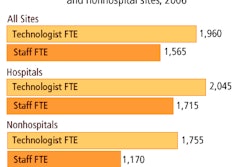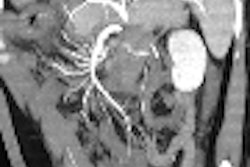CHICAGO - A just-concluded five-year lung cancer screening study found that tumor doubling times can be very long in nearly a quarter of female patients, suggesting that overdiagnosis may be a stronger factor than previously believed, at least in women.
A presentation at Wednesday's lung cancer screening sessions of the 2006 RSNA meeting highlighted the results of annual CT lung cancer screening in 1,525 patients at the Mayo Clinic in Rochester, MN.
The talk focused on the 61 cancers found in a subset of patients (24 male and 37 female; age range 53-79 years; mean age, 65 years), and particularly on the 48 cancers that were imaged more than once in annual CT screening, which offered an opportunity to measure the doubling time of solitary pulmonary nodules that were eventually diagnosed as lung cancer.
The retrospective study sought to evaluate the size, morphology, location, and morphologic change of lung nodules, and the growth rate of both incidence and prevalence of lung cancers detected in high-risk participants who underwent annual screening chest CT scans over a five-year period. The researchers also evaluated lung cancer histology and staging.
"We had a wide variety of histologies in this group," said principal investigator Dr. Rebecca Lindell. The most common histology was bronchioloalveolar carcinoma (BAC), nine in all, including ground-glass (6/9, 67%), smooth (3/9, 33%), irregular (3/9, 33%), or spiculated (3/9, 33%).
There were 25 nonpure BACs, including semisolid (11/25, 44%), solid (12/25, 48%), and irregular (14/25, 56%). Also detected were 12 squamous cell carcinomas, both solid (12/14, 86%) and irregular (10/14, 71%). Small cell and mixed small cell cancers included solid (6/7, 86%) and irregular (5/7, 71%) tumors. Finally, non-small cell lung carcinomas not otherwise specified were mostly solid (4/5, 80%) and irregular (3/5, 60%). There was one large cell, solid, speculated cancer. The average tumor size was 16.4 mm (range 5.5-52.5 mm).
Attenuation changes occurred in 44% (21/48) of the tumors imaged more than once, the researchers reported in their abstract. Margin changes occurred in 42% (20/48), most often more irregular or spiculated (16/20, 80%).
"The mean doubling time was fairly long at 518 days," Lindell said. "We had a longer volume doubing time in females (mean 688 days) than males (mean 234 days). We had fairly long volume doubling times for BAC and non-BAC adenocarcinomas, and as would be expected, these had longer volume doubling time than the other histologic subtypes."
In fact, volume doubling times were longer for women in every subtype, she said. Overall, volume doubling time was longer than 400 days in 27% (13/48) of the cancers, and 85% (11/13) of these cancers occurred in women. All of these tumors were operable, she said.
Lung cancer screening has a long history, she said. The Mayo Lung Project examined approximately 9,000 male smokers with chest x-ray but found no reduction in lung cancer mortality. Marcus et al continued the study for 13 years (Journal of the National Cancer Institute, June 7, 2006, Vol. 98:11, pp. 748-756) and again no reduction in lung cancer mortality could be seen, although the results did demonstrate improved survival in the screening arm, Lindell noted.
"It was proposed that overdiagnosis may account for the disparity between improved survival without change in mortality -- in other words, screening chest radiographs were detecting cancer that would not cause patient death," she said.
In another study, Yankelevitz et al examined stage I cancers in the Mayo Lung Project and the Memorial Sloan-Kettering lung screening project, and found that 2% of the Mayo cancers and 7% of the Memorial Sloan-Kettering cancers may have been overdiagnosed using the definition of doubling time longer than 400 days, concluding, however, that screening chest radiography does not lead to overdiagnosis.
However, the present study found 27% of tumors had doubling times longer than 400 days. One possible explanation is that CT is more sensitive than chest radiography for nodule detection. Another is the possibility of measurement error.
"The third and more intriguing possibility … is that the diagnosis of cancer (in the present study) occurred primarily (85%) in women," whereas the prior studies involved mostly men. Only 11% of male lung cancer patients had doubling times longer than 400 days.
"Overdiagnosis continues to be a concern in lung cancer screening, especially in women," Lindell concluded. The comprehensive study results will be published in Radiology, she said.
By Eric Barnes
AuntMinnie.com staff writer
November 29, 2006
Related Reading
PET, CT CAD scheme differentiates benign from malignant lung nodules, November 28, 2006
CT lung cancer screening reduces mortality, October 26, 2006
Barriers still hinder lung CAD adoption, August 24, 2006
Part II: Automated CT lung nodule assessment advances, May 16, 2006
Part I: Automated CT lung nodule assessment advances, April 17, 2006
Copyright © 2006 AuntMinnie.com



















